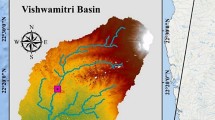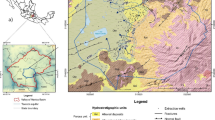Abstract
Water quality management is a significant item in the sustainable development of wetland system, since the environmental influences from the economic development are becoming more and more obvious. In this study, an inexact left-hand-side chance-constrained fuzzy multi-objective programming (ILCFMOP) approach was proposed and applied to water quality management in a wetland system to analyze the tradeoffs among multiple objectives of total net benefit, water quality, water resource utilization and water treatment cost. The ILCFMOP integrates interval programming, left-hand-side chance-constrained programming, and fuzzy multi-objective programming within an optimization framework. It can both handle multiple objectives and quantify multiple uncertainties, including fuzziness (aspiration level of objectives), randomness (pollutant release limitation), and interval parameters (e.g. water resources, and wastewater treatment costs). A representative water pollution control case study in a wetland system is employed for demonstration. The optimal schemes were analyzed under scenarios at different probabilities (p i , denotes the admissible probability of violating the constraint i). The optimal solutions indicated that, most of the objectives would decrease with increasing probability levels from scenarios 1 to 3, since a higher constraint satisfaction probability would lead to stricter decision scopes. This study is the first application of the ILCFMOP model to water quality management in a wetland system, which indicates that it is applicable to other environmental problems under uncertainties.







Similar content being viewed by others
References
Bai JH, Zhao QQ, Lu QQ et al (2013) Land-use effects on soil carbon and nitrogen in a typical plateau lakeshore wetland of China. Arch Agron Soil Sci 60(6):817–825
Beck MB (1987) Water quality modeling: a review of the analysis of uncertainty. Water Resour Res 23(8):1393–1442
Cai YP, Huang GH, Tan Q, Chen B (2011) Identification of optimal strategies for improving eco-resilience to floods in ecologically vulnerable regions of a wetland. Ecol Model 222:360–369
Charnes A, Cooper WW, Kirby P (1972) Chance constrained programming: an extension of statistical method. In: Optimizing methods in statistics. Academic Press, New York, pp 391–402
Cools J, Diallo M, Boelee E (2013) Integrating human health into wetland management for the Inner Niger Delta, Mali. Environ Sci Policy 34:34–43
Ferguson B, Mudd GM (2011) Water quality, water management and the Ranger Uranium Project: guidelines, trends and issues. Water Air Soil Pollut 217(1–4):347–363
Füreder L (1999) Richard Helmer and Ivanildo Hespanhol (eds.), Water pollution control: a guide to the use of water quality management principles. Water Air Soil Pollut 110(3–4):435–437
Gao HF, Bai JH, Xiao R, Liu PP, Jiang W, Wang JJ (2013) Levels, sources and risk assessment of trace elements in wetland soils of a typical shallow freshwater lake, China. Stoch Environ Res Risk Assess 27(1):275–284
Ham J, Yoon CG, Kim HJ, Kim HC (2010) Modeling the effects of constructed wetland on nonpoint source pollution control and reservoir water quality improvement. J Environ Sci 22(6):834–839
Hargalani FZ, Karbassi A, Monavari S (2014) A novel pollution index based on the bioavailability of elements: a study on Anzali wetland bed sediments. Stoch Environ Res Risk Assess 186(4):2329–2348
Helton AM, Bernhardt ES, Fedders A (2014) Biogeochemical regime shifts in coastal landscapes: the contrasting effects of saltwater incursion and agricultural pollution on greenhouse gas emissions from a freshwater wetland. Stoch Environ Res Risk Assess 120(1–3):133–147
Huang GH, Xia J (2001) Barriers to sustainable water quality management. J Environ Manag 61(1):1–23
Huang GH, Batez BW, Patry GG (1992) A grey linear programming approach for municipal solid waste management planning under uncertainty. Civ Eng Environ Syst 9(4):319–335
Huang GH, Baetz BW, Patry GG (1993) A grey fuzzy linear programming approach for municipal solid waste management planning under uncertainty. Civ Eng Syst 10:123–146
Huang XP, Huang LM, Yue WZ (2003) The characteristics of nutrients and eutrophication in the Pearl River estuary, South China. Mar Pollut Bull 47(1–6):30–36
Ji Y, Huang GH, Sun W (2014) Inexact left-hand-side chance-constrained programming for nonpoint-source water quality management. Water Air Soil Pollut 225:1895–1909
Jing SR, Lin YF, Shih KC, Lu HW (2008) Applications of constructed wetlands for water pollution control in Taiwan. Waste Manag 12:249–259
Li YP, Zhang N, Huang GH, Liu J (2014) Coupling fuzzy-chance constrained program with minimax regret analysis for water quality management. Stoch Environ Res Risk Assess 28(7):1769–1784
Lischeid G (2008) Non-linear visualization and analysis of large water quality data sets: a model-free basis for efficient monitoring and risk assessment. Stoch Environ Res Risk Assess 23(7):977–990
Liu Y, Cai YP, Huang GH, Dong C (2012) Interval-parameter chance-constrained fuzzy multi-objective programming for water pollution control with sustainable wetland management. Procedia Environ Sci 13:2316–2335
Lv Y, Huang GH, Sun W (2013) A solution to the water resources crisis in wetlands: development of a scenario-based modeling approach with uncertain features. Sci Total Environ 442(1):515–526
Qin Y, Yang ZF, Yang W (2011) Ecological risk assessment for water scarcity in China’s Yellow River Delta Wetland. Stoch Environ Res Risk Assess 25(5):697–711
Slowinski R, Teghem J (1990) Stochastic vs. fuzzy approaches to multiobjective mathematical programming under uncertainty. Kluwer, Dordrecht
Tan Q, Huang GH, Cai YP (2011) Radial interval chance-constrained programming for agricultural non-point source water pollution control under uncertainty. Agric Water Manag 98:1595–1606
Wei XH, Plappally AK, Soboyejo ABO et al (2012) Numerical and multivariate stochastic approaches to characterize flow in a constructed wetland basin. Stoch Environ Res Risk Assess 26(4):545–556
Xie YL, Huang GH (2014) Development of an inexact two-stage stochastic model with downside risk control for water quality management and decision analysis under uncertainty. Stoch Environ Res Risk Assess 28(6):1555–1575
Zedler JB (2003) Wetlands at your service: reducing impacts of agriculture at the watershed scale. Front Ecol Environ 1:65–72
Zedler JB, Kercher S (2005) Wetland resources: status, trends, ecosystem services, and restorability. Annu Rev Environ Resour 30:39–74
Zhang H, Huang GH (2011) Assessment of non-point source pollution using a spatial multicriteria analysis approach. Ecol Model 222(2):313–321
Zhang H, Huang GH, Wang DL, Zhang XD (2011) Uncertainty assessment of climate change impacts on the hydrology of small prairie wetlands. J Hydrol 396(1–2):94–103
Acknowledgments
This research was supported by National Basic Research Program of China (2013CB430401), National Natural Science Foundation of China (51009004), Beijing Municipal Program of Technology Transfer and Industrial Application, and the MOE Key Laboratory of Regional Energy Systems Optimization. The authors are thankful to the editor and the reviewers for their helpful suggestions and comments in improving the quality of this paper.
Author information
Authors and Affiliations
Corresponding authors
Rights and permissions
About this article
Cite this article
Ji, Y., Huang, G., Sun, W. et al. Water quality management in a wetland system using an inexact left-hand-side chance-constrained fuzzy multi-objective approach. Stoch Environ Res Risk Assess 30, 621–633 (2016). https://doi.org/10.1007/s00477-015-1094-5
Published:
Issue Date:
DOI: https://doi.org/10.1007/s00477-015-1094-5




